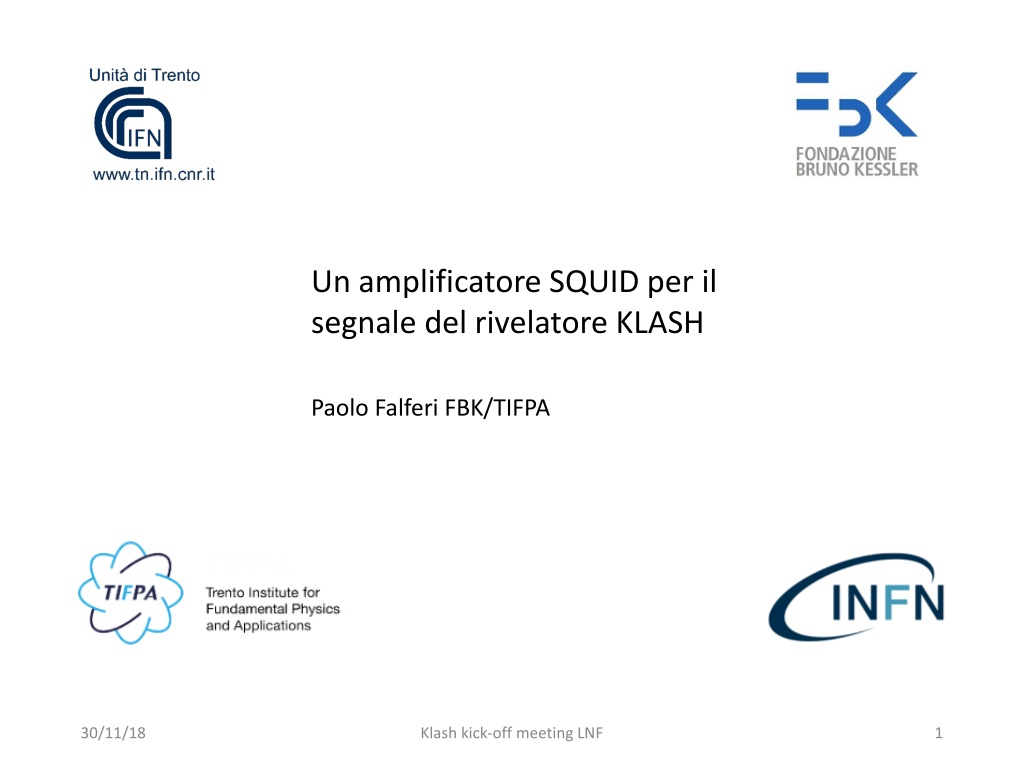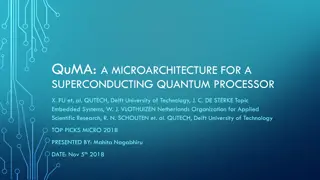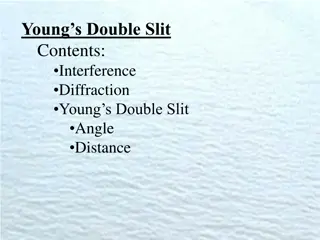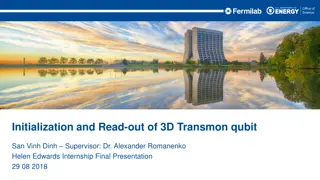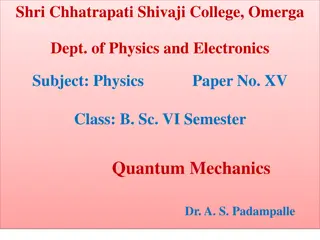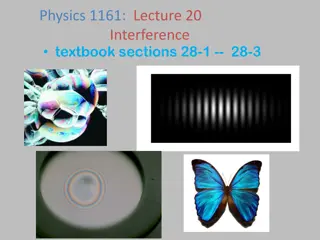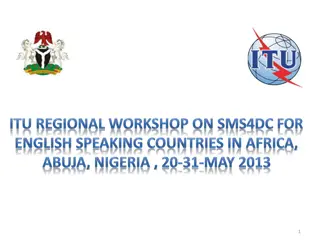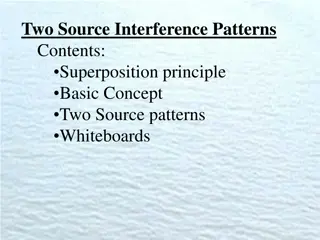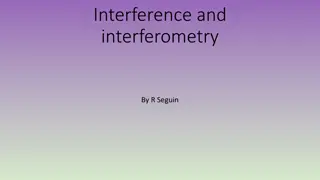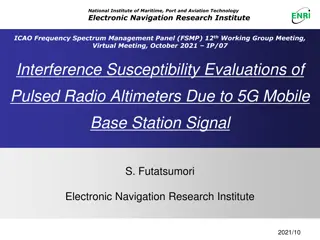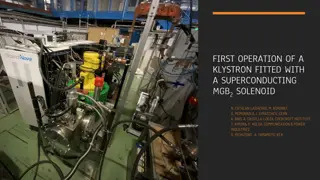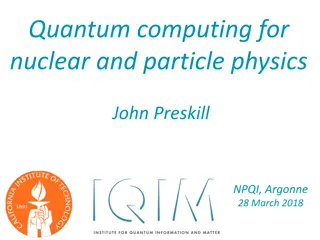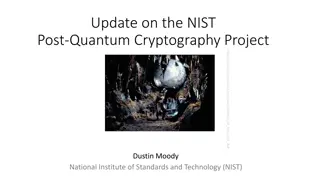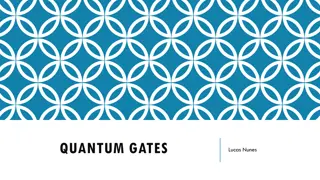Understanding the Superconducting Quantum Interference Device (SQUID)
The Superconducting Quantum Interference Device (SQUID) is a crucial component for detecting signals in devices like the KLASH detector. By combining Flux Quantization and Josephson Tunneling, the SQUID operates based on key principles such as the Josephson Equations and the Flux Quantum. Through careful design considerations and operation within specific parameters, the SQUID can effectively amplify and process signals with high sensitivity and noise suppression.
Uploaded on Sep 30, 2024 | 0 Views
Download Presentation

Please find below an Image/Link to download the presentation.
The content on the website is provided AS IS for your information and personal use only. It may not be sold, licensed, or shared on other websites without obtaining consent from the author. Download presentation by click this link. If you encounter any issues during the download, it is possible that the publisher has removed the file from their server.
E N D
Presentation Transcript
Un amplificatore SQUID per il segnale del rivelatore KLASH Paolo Falferi FBK/TIFPA 30/11/18 Klash kick-off meeting LNF 1
The dc SQUID The Superconducting Quantum Interference Device combines two phenomena Flux Quantization Josephson Tunneling =n 0(n=0, 1, 2...) I Superconductor Th: F. London (1950) Exp: Deaver and Fairbank (1961) Th: Josephson (1962) Exp: Anderson and Rowell (1963) Josephson Equations 0=h/2e 2 10-15Wb is the Flux Quantum I=I0sin = 1- 2 d /dt=2eV/ =2 V/ 0 I0is the Critical Current (maximum supercurrent) is the phase of the macroscopic wave-function that describes the Cooper pair condensate h 6.6x10-34Js is the Planck constant e 1.6x10-19C is the electron charge 30/11/18 Klash kick-off meeting LNF 2
The dc SQUID I Two Josephson junctions connected in parallel on a superconducting loop Each junction has a self-capacitance C and an added resistive shunt R Provided that (I condition) the I-V characteristic is nonhysteretic II condition: 2 kBT/I0 0<<1 V R C C= 2 I0R2C/ 0 1 . V- Characteristic I-V Characteristic Max response to a a<< 0 at a= (2n+1) 0/4 I = n 0 V Ib 2I0 I0 V ~ 20-100 V = (n+1/2) 0 I0~ 10-20 A 1 2 3 V / 0 For c<<1 V=R(I2-I02)1/2 RI for I>>I0 30/11/18 Klash kick-off meeting LNF 3
The dc SQUID From numerical simulation the SQUID response is optimized if 1) C= 2 I0R2C/ 0< 1 . 2) L= 2LI0/ 0= 1 where L=SQUID loop inductance For these conditions V Slope V R/L Transfer Function = V R/L 1/ ( LC) Flux Noise S ( ) = SV( )/V2 16kBTL2/R Energy Resolution = = S ( )/2L 9kBTL/R 16kBT LC the Noise scales with the Temperature 10-33J/Hz 10 for T=0.3K L=50pH R=2 The white noise of low-Tc SQUIDs is in general in good agreement with these predictions. 30/11/18 Klash kick-off meeting LNF 4
The dc SQUID Electronics - Flux-Locked Loop For small signals (<0.1 0) the SQUID can be operated in a linear range around the optimum working point W Flux of the Earth's magnetic field (50 T) through 10 m 10 m is 2.5 0 Flux-Locked Loop SQUID For larger signals a linearization of the transfer function is realized with a flux- locked loop (FLL) The deviation of the SQUID voltage V from that at the optimum amplified, integrated, and fed back via a feedback resistor Rfand a feedback mutual inductance Mf FLL SQUID transfer function = Rf/Mf Mi Vout G Preamp + Integrator LSQ Li working point is Mf Rf 30/11/18 Klash kick-off meeting LNF 5
The dc SQUID Electronics - Methods to Suppress Preamplifier Noise Two-stage SQUID amplifier Sensor SQUID Amplifier SQUID Matching Network Iin Vout Feedback Line In principle the noise is thermal it scales with temperature 30/11/18 Klash kick-off meeting LNF 6
The dc SQUID Electronics - Methods to Suppress Preamplifier Noise Two-stage SQUID amplifier Minimum Energy Resolution = 35 Saturation due to the Hot Electron Effect 30/11/18 Klash kick-off meeting LNF 7
The dc SQUID Practical realization Typical dc SQUID layout Square Washer - Ls=80-300 pH Fabrication Technology Uncoupled SQUID I To improve the magnetic field resolution: V larger pickup loop + multi-turn spiral input coil R. Cantor and D. Koelle Coupled SQUID I Mi Flux Transformer V Lp Li Ls Input Coil Wire-wound or Thin-film Pick-up Tight coupling (Mi2 LiLs) is obtained with multi-turn input coil integrated on top of the SQUID washer 30/11/18 Klash kick-off meeting LNF 8
Il Problema dell alta frequenza Lo SQUID per KLASH @ 70-250 MHz The conventional square-washer SQUID can be operated as a low- noise amplifier up to about 100 MHz. At higher frequencies the parasitic capacitance between the input coil and the square washer lowers the gain to useless levels 30/11/18 Klash kick-off meeting LNF 9
Il Problema dell alta frequenza Lo SQUID per KLASH @ 70-250 MHz Sono stati sviluppati diversi metodi per estendere la freq di operazione. M. A. Tarasov et al., IEEE Trans. Appl. Supercond. 2, 79 (1992) L. Spietz et al., Appl. Phys. Lett. 95, 092505 (2009) D. Drung et al., IEEE Trans. Appl. Supercond. 15, 777 (2005) 30/11/18 Klash kick-off meeting LNF 10
Il Problema dell alta frequenza Lo SQUID per KLASH @ 70-250 MHz Microstrip SQUID Amplifier (MSA) In contrast to the conventional input scheme the signal is applied between one end of the coil and the washer (the other end of the coil is left open). The washer provides the groundplane for the resulting microstrip Compared to cold semiconductor amplifiers, MSA offer lower noise (a factor 50 for < 1GHz) and much lower power dissipation. Near-quantum-limited performance in the gigahertz range The resonant frequency can be changed by connecting a varactor diode M. Muck and R. McDermott A MSA has recently replaced the HEMT amplifier of the Axion Dark Matter eXperiment that uses a microwave cavity at 800 ultracryogenic temperatures MHz operating at Quantum Noise Temperature at 700 MHz: 33mK Only one manufacturer of MSA: ez SQUID 30/11/18 Klash kick-off meeting LNF 11
Il Problema dell alta frequenza Lo SQUID per KLASH @ 70-250 MHz Accoppiamento con cavit Accoppiamento tipo ADMX cio critically coupled antenna MSA load-matched to 50 Ohm via a terminated Circulator Non sente i disturbi a basse frequenze Su ADMX funziona Funziona gi fino a 70 MHz? MSA Accoppiamento magnetico tradizionale Per non sentire rumore vibrazionale ci deve essere un accoppiamento passa alto o banda ad alto Q Va simulato e ottimizzato l intero sistema cavit -pickup-squid SQUID cavit accoppiamento risonante S = 1 m2 in 0.6 T => 300 0 SQUID 30/11/18 Klash kick-off meeting LNF 12
Lo SQUID per KLASH @ 70-250 MHz Accoppiamento magnetico con cavit Instabilit Input Impedance of the dc SQUID Amplifier its input impedance The SQUID amplifier Mi Iin Vout G Li H Li Z Mf Mi-f Zin= i Li+ Z( , Ibias, , .) Usually negligible. Important with high Q input load and at high frequency signals (~MHz) ! 30/11/18 Klash kick-off meeting LNF 13
Lo SQUID per KLASH @ 70-250 MHz Accoppiamento magnetico con cavit Instabilit Feedback cooling D(f) =D0/(1+if/fD) 30/11/18 Klash kick-off meeting LNF 14
Lo SQUID per KLASH @ 70-250 MHz Accoppiamento magnetico con cavit Instabilit Feedback cooling D0=2 Resonance Frequency = 11.5 kHz Operating Temperature = 135 mK Minimum Effective Temperature = 14 K D0=10 D0=50 D0=100 Power spectral density of the SQUID input current for four different values of the feedback amplifier gain D0 30/11/18 Klash kick-off meeting LNF 15
Lo SQUID per KLASH @ 70-250 MHz Accoppiamento magnetico con cavit Back-action noise FLL SQUID Noise Model Vn Li Mi G LSQ Li In Back-action Noise Usually negligible. Important with high Q input load and at high frequency (~MHz) 2 SQ k TL Additive Noise B RM S 16 ! i 2 i k T 11 2 2 B S M v i R 30/11/18 Klash kick-off meeting LNF 16
Things to do list Verificare la possibilit di utilizzo di un Microstrip SQUID Amplifier fino a 70 MHz e nel caso acquistarne uno (ezSQUID) Costruzione di una test facility operante in LHe Acquisire e testare sensori SQUID custom realizzati per alta frequenza (bassa capacit parassita fra input coil e SQUID loop) da Supracon? PTB/Magnicon? IBS/Corea? Elettronica dedicata, veloce e a basso rumore, su modello di quella del PTB Cavo criogenico speciale pi corto possibile tra elettronica e sensore squid Progettazione FEM del sistema cavit pick-up linea risonante SQUID con ottimizzazione del rumore Costruzione di una linea risonante a basse perdite tra pick-up e induttanza di ingresso dello SQUID 30/11/18 Klash kick-off meeting LNF 17
Magnetometers and Gradiometers Magnetometers for High Field Resolution Magnetometers for High Spatial Resolution (for scanning magnetic microscopes) High field resolution High spatial resolution large pickup loop small pickup loop ( 10 m) thin-film or wire-wound coil connected to a coupled SQUID SQUID loop as pickup (uncoupled SQUID) Best performance SB 1/2= 0.9 fT/Hz1/2 Mi Ls Lp Li Flux Transformer Wire-wound or Thin-film Pickup
Magnetometers and Gradiometers When the magnetic field source is "distant" or the environment is magnetically noisy (a) Magnetometer (b) First-derivative axial gradiometer (c) Second-derivative axial gradiometer (d) Thin-film planar first-order gradiometer (parallel and series pick-up loops) Magnetometer GRADIOMETER Thin-Film Planar Gradiometers Two-dimensional film Planar Gradiometers (activity in brain or heart) and Miniature Susceptometers (magnetic properties of particles down to 10 m diam and magnetic calorimeter x-ray detectors ) Wire-Wound Axial Gradiometers deep-lying sources Long baseline axial gradiometers A. Braginski and J. Clarke wire-wound pickup coils transformer-coupled to the SQUID pick-up balance up to 0.001% (with high-precision fabrication and post-assembly balancing)
Noise Sources of the dc SQUID Amplifier Noise Temperature Quantum Magnetics two-stage SQUID iv S = Im2 2 2 T S S k S S k n i v B i v B 8.9 kHz True Energy Resolution = k BT 0 n Noise Impedance Energy Resolution from additive noise is incomplete 1 ' i S L = iv S iv S + 2 Im Im S S S i = v i Z n i L S ( ) i = = 2 SQ Z S S L k i n v i i 2 i 2 2 M
C Ci Vout A Lp Li L R Ci
